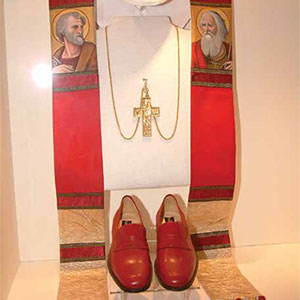
Protecting The Priceless
One-of-a-kind facility uses advanced video analytics and megapixel technology
- By Wendi Burke
- May 01, 2013
 The National Museum of Funeral History in Houston houses the
country’s largest collection of funeral service artifacts and highlights
renowned exhibits on one of man’s oldest cultural customs. The museum
features the mourning rituals of ancient civilizations, items
used in the funerals of U.S. presidents and Vatican popes, and the
rich heritage of the industry that cares for the dead.
The National Museum of Funeral History in Houston houses the
country’s largest collection of funeral service artifacts and highlights
renowned exhibits on one of man’s oldest cultural customs. The museum
features the mourning rituals of ancient civilizations, items
used in the funerals of U.S. presidents and Vatican popes, and the
rich heritage of the industry that cares for the dead.
Recently named one of the “Ten Places to See in Houston,” the museum has
deployed an integrated system comprised of advanced Acuity-vct video analytics
software and an array of IQinVision HD megapixel cameras to protect its many
exhibits and priceless artifacts.
In 2008, museum vice chairman and CEO Bob Boetticher knew his new papal
exhibit was going to increase museum attendance dramatically, as well as the number
of priceless artifacts to protect. While attending the American Association of
Museums tradeshow, he discovered Acuity-vct’s booth, where he met Dan Lazuta,
Acuity-vct director of sales.
“Dan demonstrated his system and basically he had a camera focused on a
framed picture,” Boettchier said. “Then, using his software, protection zones were
placed on designated areas of the picture. If any of these zones were disturbed,
an alarm immediately went off. We were definitely intrigued and I knew rather
quickly we had finally found what we’d been looking for.”
Up to that point, Boetticher and his staff had been purchasing off-the-shelf
cameras to keep an eye on things, but a more sophisticated system was critical to
moving forward.
“I’m a funeral director by trade, so we brought Acuity-vct in to provide additional
demonstrations, set up the system to fit our security and protection needs,
and to recommend the right kind of cameras,” Boetticher said. “We stressed the
value of many of the items that would be on display and that it was critical we have
extremely clear video. After seeing the quality the IQeye megapixel cameras can
deliver, you just can’t go back to a lesser technology.”
Currently, the museum has a mix of 52 IQinVision cameras and some legacy
cameras at the facility. When a legacy camera fails, it is replaced by an IQeye camera.
Four to five additional IQeye cameras are on order as the museum continues
to expand the areas under surveillance. Most cameras are deployed inside the museum,
but a few provide surveillance for the building’s exterior and the parking lot.
Most of the museum’s exhibits are protected by Acuity-vct’s advanced motiondetection
analytics. When a protection zone around an item or exhibit is broken,
an alarm immediately goes off. The museum guard is able to get to the affected
area within 30 seconds.
“We have a guard on a raised platform as our visitors are walking through the
gift shop, so he is clearly evident,” Boetticher said. “This system works great. It
does exactly what we were told it would do when we bought it. You don’t get to
say that very often.
“We do get alarms, mostly by the Popemobile. People will lean way over the
railing to touch the vehicle. If you set off an alarm, it’s not by accident the way
we have the system designed. So we take those alarms very seriously. Sometimes a
shadow can set off an alarm, but we can easily adjust the software to prevent such
false alarms.”
Boetticher doesn’t use his Acuity-vct system and his IQinVision cameras to
protect only the Popemobile. From his main office 30 miles away from the museum
in downtown Houston, he can access all the crystal-clear, camera views when he
wants to catch up with activity at the museum.
The museum’s parking lot surveillance has proved important in thwarting airconditioner
copper theft and helping the police investigate car break-ins. Because
the museum is co-located with the Commonwealth Institute of Funeral Services,
there is a large amount of vehicular traffic. For this reason, the
museum recently invested in IQinVision 5 MP Sentinel cameras
to provide high-resolution images for the license plate recognition
software system.
This article originally appeared in the May 2013 issue of Security Today.
About the Author
Wendi Burke is the Senior Director of Marketing for 3xLOGIC.